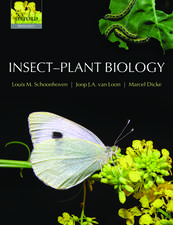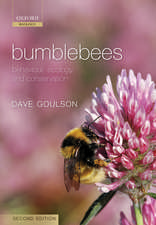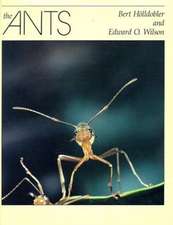Lepidoptera Conservation in a Changing World
Editat de John Dover, Martin Warren, Tim Shreeveen Limba Engleză Hardback – 13 mai 2011
| Toate formatele și edițiile | Preț | Express |
|---|---|---|
| Paperback (1) | 1232.89 lei 43-57 zile | |
| SPRINGER NETHERLANDS – 16 oct 2014 | 1232.89 lei 43-57 zile | |
| Hardback (1) | 1076.12 lei 38-44 zile | |
| SPRINGER NETHERLANDS – 13 mai 2011 | 1076.12 lei 38-44 zile |
Preț: 1076.12 lei
Preț vechi: 1415.96 lei
-24% Nou
Puncte Express: 1614
Preț estimativ în valută:
205.91€ • 215.57$ • 170.38£
205.91€ • 215.57$ • 170.38£
Carte tipărită la comandă
Livrare economică 02-08 aprilie
Preluare comenzi: 021 569.72.76
Specificații
ISBN-13: 9789400714410
ISBN-10: 9400714416
Pagini: 370
Ilustrații: VII, 383 p.
Dimensiuni: 210 x 279 x 29 mm
Greutate: 1.09 kg
Ediția:2011
Editura: SPRINGER NETHERLANDS
Colecția Springer
Locul publicării:Dordrecht, Netherlands
ISBN-10: 9400714416
Pagini: 370
Ilustrații: VII, 383 p.
Dimensiuni: 210 x 279 x 29 mm
Greutate: 1.09 kg
Ediția:2011
Editura: SPRINGER NETHERLANDS
Colecția Springer
Locul publicării:Dordrecht, Netherlands
Public țintă
ResearchCuprins
Preface.- Introduction.- 2010 Assessments for Lepidoptera.- British Butterfly distributions and the 2010 target.- The development of butterfly indicators in the United Kingdom and assessments in 2010.- Moths count: recording moths for conservation in the UK.- The state of the Dutch larger moth fauna.- Recent trends in butterfly populations from north-east Spain and Andorra in the light of habitat and climate change.- Andorran butterfly monitoring scheme.- Assessing conservation status and trends for the world’s butterflies: the Sampled Red List Index approach.- Butterfly community recovery in degraded rainforest habitats in the Upper Guinean Forest Zone (Kakum Forest, Ghana).- Conservation of butterflies in Japan: status, actions and strategy.- Climate Change Impacts and Adaptation.- Recent evidence for the climate change threat to Lepidoptera and other insects.- Synchronisation of egg hatching of brown hairstreak (Thecla betulae) and budburst of blackthorn (Prunus spinosa) in a warmer future.- The Science of Conservation Management.- Evidence based conservation of butterflies.- Butterfly abundance in a warming climate: patterns in space and time are not congruent.- Declines of prairie butterflies in the midwestern USA.- Habitat preferences of Maculinea arion and its Myrmica host ants: implications for habitat management in Italian Alps.- Not only butterflies: managing ants on road verges to benefit Phengaris (Maculinea) butterflies.- Butterflies on the brink: habitat requirements for declining populations of the marsh fritillary (Euphydryas aurinia) in SW England.- The effects of habitat fragmentation on niche requirements of the marsh fritillary, Euphydryas aurinia, (Rottemburg, 1775) on calcareous grasslands in southern UK.- Leptidea sinapis (wood white butterfly) egg-laying habitat and adult dispersal studies in Herefordshire.- New tools to boost butterfly habitat quality in existing grassbuffer strips.- What can sown wildflower strips contribute to butterfly conservation?: an example from a Swiss lowland agricultural landscape.- Land-use, environment, and their impact on butterfly populations in a mountainous pastoral landscape: individual species distribution and abundance.- Landscape-scale Conservation.- Landscape scale conservation: resources, behaviour, the matrix and opportunities.- Habitat resources, remnant vegetation condition and area determine distribution patterns and abundance of butterflies and day-flying moths in a fragmented urban landscape, south-west Western Australia.- High and dry or sunk and dunked: lessons for tallgrass prairies from quaking bogs.- Landscape-scale conservation in practice: lessons from northern England, UK.- Securing viable metapopulations of the marsh fritillary butterfly, Euphydryas aurinia, (Lepidoptera:Nymphalidae) in northern England.- Is the Natura 2000 network sufficient for conservation of butterfly diversity? A case study in Slovenia.- Status and conservation of Asclepiadaceae and Danaus in southern Spain.- Future Challenges.- Grassland butterflies and low intensity farming in Europe.- Developing and launching a wider countryside butterfly monitoring method.- Ten conservation challenges for 2010 and beyond to conserve Lepidoptera in Europe.- Index.
Recenzii
From the reviews:
“This volume is an essential resource for anyone interested in conservation for insects in general, and especially for Lepidoptera. I would also recommend this to those interested in lepidopteran biology in general since significant articles within cover the natural history, behavior, and ecology of many key species. Most notably the papers on efficient surveying techniques will be valuable for monitoring lepidopteran biodiversity in our current environment of fiscal austerity.” (Jason J. Dombroskie, The Quarterly Review of Biology, Vol. 89 (2), June, 2014)
“This volume is an essential resource for anyone interested in conservation for insects in general, and especially for Lepidoptera. I would also recommend this to those interested in lepidopteran biology in general since significant articles within cover the natural history, behavior, and ecology of many key species. Most notably the papers on efficient surveying techniques will be valuable for monitoring lepidopteran biodiversity in our current environment of fiscal austerity.” (Jason J. Dombroskie, The Quarterly Review of Biology, Vol. 89 (2), June, 2014)
Textul de pe ultima copertă
To scientists and conservationists alike Lepidoptera, butterflies and moths, are attractive species, not simply because many are exceptionally beautiful, with fascinating life cycles, delicate habitat associations, and astonishing interactions with other species, but because they are extraordinarily sensitive to changes in their environment. They act as a bellwether, alerting us to changes that human beings are doing to our environment. This book, edited by John Dover, Martin Warren and Tim Shreeve, is a collection of 31 of the papers presented at the International Symposium: ‘The 2010 Target and Beyond for Lepidoptera’ organised by the environmental charity Butterfly Conservation. The meeting was convened to assess whether the Convention on Biological Diversity and EU targets to halt biodiversity loss by 2010 had been met. The papers presented at the meeting were sobering; butterflies and moths are still in severe decline in countries across the world. As butterflies and moths can be regarded as an above-ground ‘miner’s canary’, then humans have cause to worry if these trends continue. The meeting, and this book, is not all about doom and gloom – yes, it documents problems and highlights very serious challenges, but it also shines light on research that promises to help reverse conservation losses. The book is wide in scope and, for example, includes research on how to improve road verges for rare butterflies in the Netherlands and how agri-environment schemes in Switzerland and the UK can boost butterfly numbers. It shows how studying butterflies in natural bog systems in the USA can help us understand how to conserve butterflies in fragmented prairie habitats and what determines where we find butterflies in the urban landscape of western Australia. The Convention on Biological Diversity is formulating new targets for 2020, and a vision for 2050 - if we are to improve the status of Lepidoptera by 2020 the research documented in this bookwill help us get there – but the book outlines the huge challenges we face.
Caracteristici
Preface by Sir David Attenborough An authoritative overview of the state of Lepidoptera in countries across the world Presents new research into the challenges facing butterflies and moths in natural and man-made habitats Provides examples of how research can translate into biodiversity gains and inform conservation efforts













